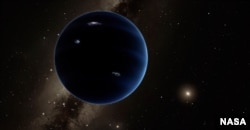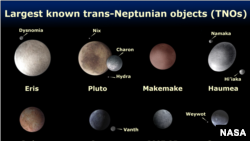Delta4Embassy
Gold Member
http://phys.org/news/2015-12-discovery-large-outer-edges-solar.html
"(Phys.org)—Two separate teams of researchers (one from Mexico, the other Sweden), have incited skepticism among the astronomy community by posting papers on the preprint server arXiv each describing a different large object they observed in the outer edges of the solar system. Both teams made their observations after reviewing data from ALMA—a cluster of radio dishes in the Chilean mountains.
One of the objects was found to be near W Aquilae in the night sky—the other adjacent to Alpha Centauri . Both groups report being skeptical at first regarding a faint glow, but monitored what they had seen nonetheless—to their surprise they found that the objects appeared to move relative to the stars behind them, which suggested they might be relatively close and that they might be orbiting the sun. Neither group was able to gain much evidence regarding the properties of the objects they had spied, because both of them were only able to make two observations, but both teams suggest there was enough data to allow for ruling out the object being an ordinary star.
The Swedish team nick-named the object they observed Gna, after a Nordic God known for its swiftness, and have told the press they had no intention of suggesting they had found the mythical Planet X which supposedly lies somewhere beyond Pluto. Instead they suggest it might be a large asteroid. The team from Mexico went a little further suggesting that the object they observed might possibly turn out to be a brown dwarf.
There is also the possibility, as some astronomers who have read the two papers suggest, that either or both of the objects are merely illusions, random blips or noise that for a moment or two appeared to take the shape of a very far away object. Some have even tweeted their opinions, insinuating that jumping on the Planet X bandwagon would be sheer folly.
Despite the skepticism, it is likely that other research groups will be training their instruments on the piece of sky where the objects were possibly seen, to prove or disprove their existence and to put a stop to the conjecture. Both of the teams involved have voiced their support of such efforts, noting that they would like an explanation for what they observed. "
Been longrunning speculation than our solar system includes some object that regularly disturbs asteroids in the Ort cloud sending them further in to the system occasionally smacking into the Earth causing mass extinctions. This might be that.
"(Phys.org)—Two separate teams of researchers (one from Mexico, the other Sweden), have incited skepticism among the astronomy community by posting papers on the preprint server arXiv each describing a different large object they observed in the outer edges of the solar system. Both teams made their observations after reviewing data from ALMA—a cluster of radio dishes in the Chilean mountains.
One of the objects was found to be near W Aquilae in the night sky—the other adjacent to Alpha Centauri . Both groups report being skeptical at first regarding a faint glow, but monitored what they had seen nonetheless—to their surprise they found that the objects appeared to move relative to the stars behind them, which suggested they might be relatively close and that they might be orbiting the sun. Neither group was able to gain much evidence regarding the properties of the objects they had spied, because both of them were only able to make two observations, but both teams suggest there was enough data to allow for ruling out the object being an ordinary star.
The Swedish team nick-named the object they observed Gna, after a Nordic God known for its swiftness, and have told the press they had no intention of suggesting they had found the mythical Planet X which supposedly lies somewhere beyond Pluto. Instead they suggest it might be a large asteroid. The team from Mexico went a little further suggesting that the object they observed might possibly turn out to be a brown dwarf.
There is also the possibility, as some astronomers who have read the two papers suggest, that either or both of the objects are merely illusions, random blips or noise that for a moment or two appeared to take the shape of a very far away object. Some have even tweeted their opinions, insinuating that jumping on the Planet X bandwagon would be sheer folly.
Despite the skepticism, it is likely that other research groups will be training their instruments on the piece of sky where the objects were possibly seen, to prove or disprove their existence and to put a stop to the conjecture. Both of the teams involved have voiced their support of such efforts, noting that they would like an explanation for what they observed. "
Been longrunning speculation than our solar system includes some object that regularly disturbs asteroids in the Ort cloud sending them further in to the system occasionally smacking into the Earth causing mass extinctions. This might be that.





